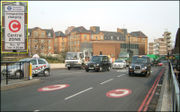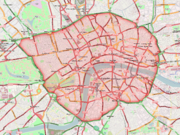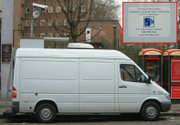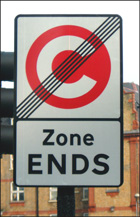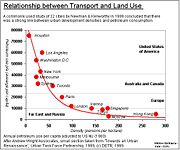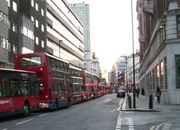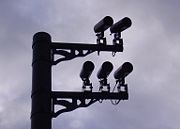London congestion charge
2008/9 Schools Wikipedia Selection. Related subjects: Road transport
The London congestion charge is a fee for some motorists travelling within those parts of London designated as the Congestion Charge Zone (CCZ). The main objectives of this charge are to reduce congestion, and to raise funds for investment in London's transport system. The zone came into operation in parts of Central London on 17 February 2003 and it was extended into parts of West London on 19 February 2007. Although not the first scheme of its kind in the United Kingdom, it was the largest when it was introduced, and it remains one of the largest in the world. Worldwide, several cities have referenced the London scheme when considering their own possible schemes. A payment of £8 is required for each day a chargeable vehicle enters or travels within the zone between 7 am and 6 pm; a fine is imposed for non-payment.
The organisation responsible for the charge is Transport for London (TfL); Capita Group operates the scheme under contract. The system is run on a generally automatic basis using CCTV and Automatic Number Plate Recognition.
The congestion charge has been controversial, with reported effects not only on traffic levels but on business activity and the local environment. The revenue raised from the charge has not matched the amounts predicted. A subject of political debate, the charge has been an issue during London mayoral elections.
Coverage
Area covered by the charge
The boundary of the zone, as of 19 February 2007, starts at the northern end of Vauxhall Bridge and (travelling in a clockwise direction) heads along the northern bank of the River Thames as Grosvenor Road, the Chelsea Embankment and Cheyne Walk. From there, it heads north, along the eastern edges of the Kensington and Earl's Court one-way systems, part of the A3220, with the roads in between charged, before continuing to the A40 Westway as the Holland Road and the West Cross Route. The boundary then includes parts of North Kensington, but the actual boundary is defined by the West London Line railway track, which runs between Latimer Road (inside the zone) and Wood Lane (outside the zone), until Scrubs Lane, before turning east, following the Great Western Main Line out of Paddington towards Ladbroke Grove. Here, the boundary follows the Grand Union Canal and rejoins the existing zone at Edgware Road after skirting Paddington, by way of the Bishop's Bridge Road, Eastbourne Terrace, Praed Street and Sussex Gardens.
TfL has defined some free through routes, where drivers do not have to pay the charge. The main route is defined by the western boundary of the original zone Vauxhall Bridge Road, Grosvenor Place, Park Lane and Edgware Road, with some additions around Victoria. The Westway is the other exempt route.
Original area covered
The original boundary of the zone (2003- 02-17 – 2007- 02-18) was largely the London Inner Ring Road. Starting at the northernmost point and moving clockwise, the major roads defining the boundary were Pentonville Road, City Road, Old Street, Commercial Street, Mansell Street, Tower Bridge Road, New Kent Road, Elephant and Castle, Vauxhall Bridge Road, Park Lane, Edgware Road, Marylebone Road and Euston Road (other roads filled the small gaps between these roads). The zone therefore included the whole of the City of London, the financial district, and the West End, London's primary commercial and entertainment centre. There were 136,000 residents living within the zone (of a total population of around 7,000,000 in Greater London), though the zone was primarily thought of (and zoned) as commercial rather than residential. There was little heavy industry within the zone. Signs were erected and symbols painted on the road to help drivers recognise the congestion charge area.
Payment and concessions
Payment
As of 4 July 2005, the non-discounted daily charge for non-exempt vehicles is £8, or £7 for fleet vehicles. Any applicable daily charge must be paid for a vehicle that is on a public road in the Congestion Charge Zone between 7 am and 6 pm, Monday to Friday, excluding public holidays in England and a period over Christmas. Drivers may pay the charge via a website, by SMS text message, in shops equipped with a PayPoint, or by phone. The charge may be paid the day after at an increased cost of £10.
While private drivers are obliged to pay the charge either the day before, on the day or on the following day, whether they are seen to enter the zone or not, the same does not apply to fleets of business vehicles. A business can register a group of vehicles with TfL, and is charged £7 per visit for all vehicles in the fleet detected by the cameras. In May 2005, businessman Miguel Camacho set up fivepounds.co.uk, whose sole function was to sign up private drivers to their "fleet", thus offering the convenience of not having to pay the charge pro-actively, avoiding fines in the case of a forgotten journey and also potentially getting a "free journey" if undetected by the cameras. TfL, which obtains nearly half of its net revenue from fines, moved quickly to quash the loophole, by demanding that fleet operators provide the registration document for each vehicle in their fleet. Fivepounds went out of business on 26 February 2006.
Exemptions and discounts
Some vehicles such as buses, minibuses (over a certain size), taxis, ambulances, fire engines and police vehicles, motorcycles, very small three-wheelers, alternative fuel vehicles and bicycles are exempt from the charge, although some of the exemptions are 100% discounts that still require registration. Residents of the zone are eligible for a 90% discount if they pay the charge for a week or more at once, although there are administration charges – presently a minimum of £10 – for claiming the discount. Some residents who live close to the West London extension are also entitled to the resident's discount.
Drivers of foreign-registered vehicles are not exempt from the charge but the current lack of an international legal framework for the assessment and collection of traffic fines makes enforcement and recovery difficult. In 2005, The Guardian obtained documentation under the Freedom of Information Act 2000 which showed that out of 65,534 tickets issued to non UK registered vehicles, only 1,993 had been collected.
In October 2005, it was reported that two London embassies, those of the United States and Germany, were not paying the charge as they considered it to be a tax, which they are protected from paying under the Vienna Convention. Some other embassies do pay the charge. By May 2006, it was reported, the US embassy owed £270,000 in fines for non-payment. A TfL spokesperson stated that US embassies do pay tolls in Oslo and Singapore. TfL argues that the charge is a toll, not a tax. In April 2006, after not paying it since its introduction in February 2003, the embassy of the United Arab Emirates decided that its diplomats would now pay the charge.
TfL can and does suspend the congestion charge either in a small local area to cope with incidents and if directed to do so by a police officer. The congestion charge was suspended on 7 July and 8 July 2005, in response to the terrorist attacks on London Transport.
Penalties and avoidance
Failure to pay results in a fine of £120, reduced to £60 if paid within 14 days, but increased to £180 if unpaid after 28 days. Although avoidance has become more sophisticated, compliance with the scheme and terms of payment has improved over the last few years, as is evidenced by the income from penalties dropping by approximately a quarter between 2005 and 2007. However, even after charges were increased, enforcement charges still make up a significant proportion of the net revenues. Several newspapers have reported that copied number plates are being used to avoid the congestion charge, resulting in vehicle owners receiving penalty notices for failure to pay when their vehicles have not been inside the zone. TfL has stated it is keeping a database of these numbers and that they will trigger an alert.
In 2007, TfL was informed by a green motoring website of their allegation, that owners of luxury cars were registering their vehicles as minicabs in order to use the exemption for these vehicles. TfL responded that it carried out regular checks to confirm that cars were being used for the purposes they were registered for, and that they had not revealed any such cases.
New emissions based fee structure
From October 2008 a new charging structure will be introduced, which will have charge bands loosely based on potential vehicle emissions. The Mayor of London states that the changes will include a new charge for cars and certain pickup trucks with the highest greenhouse gas emissions, and a discount for cars with the lowest greenhouse gas emissions
Detail
On 2008- 02-12 TfL announced that on 2008- 10-27 they will introduce a new charging structure for vehicles entering the congestion zone, based on potential CO2 emission rates.
The main change will be the introduction of two new fees:
- £25 per day (with no residents' discount) for cars which, if first registered on or after 2001- 03-01 are rated in Vehicle Excise Duty (VED) "Band G" (emitting above 225g/km of CO2), or if first registered before 2001- 03-01 have an engine capacity of greater than 3000 cc and for pickups with two rows of seats which either are rated as emitting above 225g/km of CO2 or which have an engine capacity of greater than 3000 cc. It should be noted that in Alistair Darling's 2008 budget it was announced that VED Band G would be lowered to 151g/km of CO2. Transport for London have not yet clarified whether the £25 daily charge will be linked to the band when the changes take effect.
- £0 per day (a 100% discount) for cars that either are rated as emitting less than 120g/km CO2 and which meet the Euro 4 air pollution emissions standard or which are rated as emitting no more than 120g/km CO2 and which appear on the PowerShift register.
Background
Towards the end of 2006, Livingstone proposed the introduction of a variable congestion charge, based on the Vehicle Excise Duty (VED) bands. This would reduce or eliminate the charge for Band A vehicles, and increase it to up to £25 a day for Band G vehicles, that is, CO2 emissions of greater than 225 g/km. Some vehicle categories are already exempt from the charge. Consultation on these proposals began in August 2007. According to a report commissioned by Land Rover by the Centre for Economics and Business Research think tank, this scheme would increase pollution. Consultation ended on 19 October 2007.
Controversy
Acting director of the RAC Sheila Raingner stated that "The congestion charge was originally developed to reduce congestion. Changing this will confuse the public and reduce support and trust for future initiatives." The scheme has also been critisised by car manufacturer Porsche, who announced they intend to request a judicial review. They claim the new charges are disproportionately high, and will not make a 'meaningful difference' to the environment.
Operations and technology
Whilst TfL is responsible for the scheme, the operation is sub-contracted to an outside company. From the scheme's inception, Capita Group has been responsible for its day-to-day operation under a five-year contract worth around £230m. Having been threatened with the termination of the contract by Livingstone for poor performance, when the zone was subsequently extended, Capita was awarded an extension to the original contract up until February 2009 to cover the expanded zone. Capita has employed sub-contractors including Mastek, based in Mumbai, India, who are responsible for much of the Information Technology infrastructure. Due to the wide spread around the globe of sub-contractors and because some data protection regulations vary from country to country, the scheme has prompted concerns about privacy from technology specialists. Transport for London have announced that from 2009 IBM will operate the charge, along with the low emission zone under contract.
The scheme makes use of CCTV cameras to record vehicles entering and exiting the zone. Cameras can record number plates with a 90% accuracy rate through automatic number plate recognition (ANPR) technology. There are also a number of mobile camera units which may be deployed anywhere in the zone. The majority of vehicles within the zone are captured on camera. The cameras take two still pictures in colour and black and white and use infrared technology to identify the number plates. These identified numbers are checked against the list of payees overnight by computer. In those cases when a number plate has not been recognised then they are checked by humans. Those that have paid but have not been seen in the central zone are not refunded, and those that have not paid and are seen are fined. The registered owner of such a vehicle is looked up in a database provided by the Driver and Vehicle Licensing Agency (DVLA), based in Swansea. The cameras can be fooled by tail gating or switching lanes at the correct time.
Background and history
Road tolls
Historically, private toll roads, funded by turnpike trusts, were common from the late 1600s until the Local Government Act 1888 passed ownership and responsibility to county and county borough councils. As a result the use of roads in the United Kingdom is generally free of charge, subject to the payment of the road fund licence. However, there are specific sections of public roads that remained tolled, which are mainly bridges and tunnels as well as the M6 toll motorway. Of the many previously existing toll roads in London there remains one, College Road in Dulwich, which is privately owned by Dulwich College but accessible by the public.
Road tolls have been advocated by many others in the past, such as the 18th century economist Adam Smith, as a way of directly funding the construction and maintenance of routes.
Road pricing
The government's Smeed Report of 1964 was the first full assessment of the practicality of road pricing in a British city on the basis of congestion. It recommended a method of "car user restraint" by a variable system of charging for road usage - if the government had the will to do so. During the early years of the Greater London Council the first plans were drawn up for a system of cordon charging or supplementary licensing for use in the central area. A formal study was undertaken into the merits of the scheme, and in 1973 concluded that it would improve traffic and environmental conditions in the centre. However, the newly elected Labour council rejected the study's findings in favour of greater investment in public transport. In 1995, the London Congestion Research Programme concluded that the city's economy would benefit from a congestion charge scheme, and the Road Traffic Reduction Act 1997 required local authorities to study and reduce traffic volumes.
The power to introduce "Road user charging" was given to any future mayor in the Greater London Authority Act 1999. Ken Livingstone had proposed in his manifesto to introduce a £5 charge for vehicles entering Central London. Following his victory, the Mayor made a draft order and requested a report from TfL, which summarised the reasons for introducing the scheme. The scheme was to be introduced to reduce congestion in the centre of the capital following the Draft Transport Strategy of January 2001 which had highlighted the importance that the Mayor placed on tackling this issue. The charge was to be part of a series of measures to improve the transport system in London and was to combined with public transport improvements, increased enforcement of parking and traffic regulations. The report stated that the scheme was expected to be the most effective in reducing through traffic, reducing congestion both within and outside the zone, improving the speed of buses and the quality of life in Central London. It was stated that improved traffic flows would make London more attractive to business investment. Substantial net revenues were anticipated, which were to be invested in London's transport system. It also states that 90% of those who responded to a consultation on the scheme, viewed reducing traffic congestion in central London as 'important'.
Having won the first mayoral election in 2000, Ken Livingstone opted to exercise these powers as promised in his independent manifesto, and carried out a series of consultations with interested parties with the basic scheme agreed in February 2002. Around this time, England's first congestion charging scheme was introduced in Durham, it was restricted to a single road in that city, with a £2 charge.
Central London
The London congestion charge commenced operation on 17 February 2003. Before the charge's introduction, there were fears of a very chaotic few days as the charge bedded down. Indeed Ken Livingstone, Mayor of London and key proponent of the charge, himself predicted a "difficult few days" and a "bloody day".
In July 2002, Westminster Council launched a legal challenge against the plans, arguing that they would increase pollution and were a breach of human rights of residents on the boundary of the zone. The High Court rejected the claim. On introduction, the scheme was the largest ever undertaken by a capital city.
After the introduction of the charge, there were a number of suggestions for its future. Soon after charging commenced, Livingstone announced that he would carry out a formal review of the charge's success or failure six months after its introduction – brought forward from one year, following the smooth start. On 25 February 2003 Livingstone stated, "I can't conceive of any circumstances in the foreseeable future where we would want to change the charge, although perhaps ten years down the line it may be necessary" referring to the amount that drivers have to pay, indicating that £5 was sufficient to bring about the reduction in traffic that he had hoped for. By November 2004, Livingstone directly contradicted his earlier stance and said in an interview with BBC London, "I have always said that during this term [his second term in office] it will go up to at least £6." By the end of the month, Livingstone changed his position again, saying in an announcement that, in fact, the rise would be to £8 for private vehicles and £7 for commercial traffic. Business groups such as London First said following the announcement that the charges were "totally unsatisfactory and unacceptable". The rise to £8 was announced formally on 1 April 2005, along with discounts for drivers buying month or year-long tickets. On 10 May 2006, in a live TV debate, Livingstone supported a rise in the charge to £10 by 2008.
Western extension
In February 2004, TfL issued a consultation document on the expansion of the zone to the west that would cover the rest (western portion) of Westminster and the Royal Borough of Kensington and Chelsea. The extension covered around 230,000 residents, compared with the 150,000 in the original zone.
In August 2004, following Livingstone's re-election in the June 2004 mayoral election, the results of the consultation were published. A substantial majority of respondents did not want the extension, however Livingstone said he was going ahead and that the consultation was a charade. Protests continued against the extension, with residents arguing that only 5% of the road space in the selected area was congested. Following on in May 2005 TfL a further consultation began with specific proposals about the extensions. These included a plan to reduce the operating hours of the charge by half-an-hour to "boost trade at London's theatres, restaurants and cinemas". At the end of September 2005, London Mayor Ken Livingstone confirmed the western expansion of the congestion charge, to come into effect on 19 February 2007 despite the majority of residents opposing it in the two consultations. It was expected that the extension would increase congestion in the zone by around 5% as the 60,000 residents in the new zone will be entitled to the discounts available. Several roads were also to be left charge-free between the original zone and the extension.
Since the introduction of the western extension, TfL has made a number of bus route changes to take advantage of the presumed higher traffic speeds and the greater demand for public transport. One new route ( route 452) has been introduced and three others (routes 31, 46 and 430) have been extended. In addition, the frequency of buses on other routes through the zone extension has been increased.
Effects
The effects of the congestion charge have been controversial. Studies have been made of its effects on congestion, traffic levels, road safety, the use of public transport, the environment, and business activity matters. A report published by TfL in October 2004 stated that only seven of the 13 government aims for London transport would be met by 2010. The target on reducing congestion for Greater London overall will not be met, the report said.
Traffic changes
A year before the congestion zone, TfL set up automatic traffic counters and augmented them with regular classified traffic counts at key locations, in order to monitor long term trends. Their results are reviewed and reported annually.
A report by TfL in early 2007 indicated that there were 2.27 traffic delays per kilometre in the original charging zone. This compared with a figure of 2.3 before the introduction of the congestion charge. After the scheme was introduced they had measured an improvement in journey times of 0.7 minutes per km, or 30%. This improvement had decreased to 22% in 2006, and during 2006 congestion levels had increased so that the improvement, compared to the year before the scheme, was just 7%. TfL explained this as a result of changes to road priorities within the zone, delays caused by new pedestrian and road user safety schemes, and, most particularly, a doubling of road works in the latter half of 2006. (Utilities were encouraged to complete planned road works in the year proceeding the congestion charge, so it would appear that the first year of measurement used for later comparisons would also have been affected by streetworks to some extent.)
TfL's report in June 2007 found that the level of traffic of all vehicle types entering the central Congestion Charge Zone was now consistently 16% lower in 2006 than the pre-charge levels in 2002. The conservative Bow Group noted that the main effect occurred after 11 am.
Breaking down that figure showed the number of chargeable vehicles entering the zone had reduced by 30% (primarily cars and minicabs, although vans and lorries had decreased by 13%), while there were overall increases in the numbers of taxis, buses, and especially bicycles. The daily profile of traffic flows had changed, with less traffic after 9.30 am and a peak immediately before and after the end of the charging period. The level of traffic entering the zone during the morning peak had not reduced as much as at other times. They had noted a small but pervasive long term trend of less traffic entering the zone, expected to be a result of people changing their location and lifestyle, perhaps influenced by the charge. Once within the charging zone car and delivery traffic remained unchanged, suggesting that the journeys made by residents and businesses within the zone were broadly unaffected. Changes to the road network over the years has made direct comparisons difficult, but TfL suspect that certain routes used heavily by taxis and buses within the zone have seen substantially increased traffic. On some of the boundary roads traffic numbers had increased slightly but congestion and delays were largely unchanged from 2002 levels. Year on year, counts of inbound traffic approaching the zone had also seen a distinct and significant 5–7% decline in the number of chargeable vehicles, which was unexplained.
The charge operates for under one third of the hours in a year and covers around two thirds of the central London traffic. In total 8% of traffic kilometres are affected by the scheme. TfL have extrapolated the trends in road speed in the congestion zone; they have suggested that speeds would have dropped from 17 km/h in 2003 to 11.5 km/h by 2006, had the scheme not been put in place.
Following the introduction of the Western Extension, TfL stated that traffic had fallen around 10 to 15% in the extended zone. The original zone is showing a 4% increase in congestion following expansion of the congestion charge and the introduction of extended to discounts to residents of the new zone and buffer zone. TfL assessed the increase in charges in 2005 to have had only a slight impact overall.
Although it was suggested that the scheme should improve the speed of vehicles in the centre, the London Ambulance Service (LAS) anticipated increased volumes of traffic around the edge of the zone and an increase in demand within the zone, that might both adversely affect clinical outcomes. However, since then, survival rates for LAS' witnessed cardiac arrests have tripled across Greater London. LAS attributes these improvements to equipment availability and operational processes, such as the deployment of four-wheeled and two-wheeled rapid response units that can weave through congestion more quickly. This, and TfL's increase in the number central London traffic calming measures, would suggest that other much more significant factors have masked any congestion charge-related changes in outcome, either up or down. In addition, like some other essential services, LAS felt it necessary to divert about £¼M from their budget to pay congestion charge allowances for key staff affected by the charges during their journey to work.
A November 2007 report, stated that TfL data shows that after an initial improvement, that rush-hour congestion has become worse than it was before the congestion charge was introduced. In December 2007, another article contained a similar observation, that although after the first year the results were looking good, with traffic speeds up, that at the time of writing, traffic speeds and delays were virtually back to their February 2003 levels.
Road safety
TfL have estimated that the charge appeared to have a small impact on the number of road traffic accidents – but this was much less than the national and London trend towards fewer accidents. There were 2,598 personal injury road traffic accidents inside the zone in the year before the scheme. This fell by about 200 each year to 1,629 in 2005. TfL's statisticians have extrapolated an estimate that between 40 and 70 injuries have been avoided annually because of the charging zone, with most of the rest attributed to the changes that altered and slowed down the road network "in favour of the people-moving capacity of the network."
TfL expects that many of these road safety interventions would have occurred irrespective of the introduction of congestion charging. Cars and motorcycles have seen the biggest reduction in accidents, whereas bicyclists have seen a slight increase, which perhaps reflects their increased numbers. For comparison, the inner ring road also saw a substantial drop as accidents fell from 961 to 632, which was slightly less than the average for Greater London.
Number plate cloning
Another effect of the scheme, which relies on the recognition of vehicle number plates to enforce the charge, is that it has led to an increase in the number of cars carrying false number plates. Fines for non-payment of the charge are sent to the registered keeper of the number plate, without first checking whether the vehicle to which the plate belongs was actually the offending vehicle, the onus being placed on the keeper to prove their innocence. Car breakers are amongst those being targeted as a source for number plates to be illegally used on other vehicles. The BBC reported in October 2005 that the AA Motoring Trust estimated that 1 in 250 cars entering the charging zone were displaying false plates. In 2006 police estimated that more than 40,000 number plate sets were stolen.
Public transport
On the launch date of the original zone, an extra 300 buses (out of a total of around 20,000) were introduced. Bus and London Underground managers reported that buses and tubes were little, if at all, busier than normal. Usage of the London Underground has increased by 1% above pre-charge levels, having fallen substantially in 2003/2004, whilst bus patronage in the Central London area (not the same at the Congestion Charge Zone) had stabilised at 116,000 journeys per day after increasing from under 90,000 pre-charge. No change in National Rail patronage had been noted as a result of the introduction of the central zone charge.
Business
Reports have shops and businesses being heavily impacted by the cost of the charge, both in terms of lost sales and increased delivery costs as recognised by the London Chamber of Commerce.
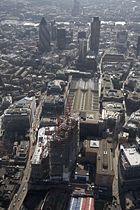
In August 2003, the John Lewis Partnership announced that in the first six months of the charge's operation, sales at their Oxford Street store fell by 7.3% whilst sales at other stores in the Greater London area but outside the Congestion Charge Zone rose by 1.7%. To partly compensate for the loss of revenue they extended opening hours and introduced regular Sunday opening for the first time.
However London First's own report indicated that business was broadly supportive. Subsequently another report stated that there had been a reduction in some employment in the charging zone. TfL criticised the reports as unrepresentative and that its own statistics reported no effect on business.
A report in May 2005 stated that the number of shoppers had declined by 7% year-on-year in March, 8% in April and 11% in the first two weeks of May. TfL countered that an economic downturn, the SARS outbreak and threat of terrorism were likely factors. At the same time a London Chamber of Commerce report indicated that 25% of businesses were planning on relocation following the charges introduction. However an independent report six months after the charge was implemented suggested that businesses were then supporting the charge. London First commissioned the study which reported that 49% of businesses felt the scheme was working and only 16% that it was failing. The Fourth Annual Review by TfL in 2004 indicated that business activity within the charge zone had been higher in both productivity and profitability and that the charge had a "broadly neutral impact" on the London wide economy. The Fifth Annual Review continued to show the central congestion zone outperforming the wider London economy.
It had been estimated that due to the West London extension in February 2007, 6,000 people would eventually lose their jobs. In May 2007, a survey of 150 local businesses stated they had seen an average drop in business of 25% following the introduction of the charge, which was disputed by TfL which stated that there had been "no overall effect" on business and that it had outperformed the rest of the UK in the central zone during 2006.
Environment
Surface transport accounts for 22% of London's CO2 emissions. The reduction of airbone emissions wasn't listed as one of the reasons for introducing the congestion charge. The pre commencement report from TfL noted that the scheme wasn't expected to significantly affect air quality, but that offering a discount to encourage the use of greener fuels would be a positive measure. However, TfL has reported changes in air quality within and alongside the Inner Ring Road boundary of the zone. Levels of two greenhouse gases fell, nitrous oxide (N2O), by 13.4% between 2002 & 2003, and carbon dioxide (CO2), as well as particulates (PM10). In 2007, the Fifth Annual Monitoring Report by TfL stated that between 2003 and 2006, N2O emissions fell by 17%, PM10 by 24% and CO2 by 3%, with some being attributed to the effects of reduced levels of traffic flowing better, with the majority being as a result of improved vehicle technology. In total the rate of fall in CO2 has been 20%. The TfL report makes it clear that only a one off reduction of emissions could be expected from the introduction of the charge, whilst further reductions are unlikely to be as a result of the charge.
| Charging zone | Inner Ring Road | |||||
| N2O | PM10 | CO2 | N2O | PM10 | CO2 | |
| Overall traffic emissions change 2003 versus 2002 | -13.4 | -15.5 | -16.4 | -6.9 | -6.8 | -5.4 |
| Overall traffic emissions change 2004 versus 2003 | -5.2 | -6.9 | -0.9 | -5.6 | -6.3 | -0.8 |
| Changes due to improved vehicle technology | -17.3 | -23.8 | -3.4 | -17.5 | -20.9 | -2.4 |
| Source: Transport for London 2003–2004 figures are TfL estimates. | ||||||
National trends had already shown a rapid decline of some other emissions during the late 1990s, notably carbon monoxide, and levels have been relatively stable since 2002 across London. Since 2002 the nitrogen dioxide (NO2) produced by diesel exhaust has become a serious problem, with the London Air Quality Network of King's College London reporting that the annual mean NO2 objective (of 40 μgm-3 or 21 ppb) was exceeded at all kerbside and roadside monitoring sites across central and greater London during 12 months between 2005 and 2006. Although no areas within the Congestion Charge Zone reported NO2 levels above an upper limit of 200 μgm-3 (105 ppb), some monitoring areas near the zone boundary experienced very long periods at such levels, notably the A23 near Brixton (3741 hours) and the Marylebone Road (849 hours). TfL report that emissions may not necessarily feed through into improvements in air quality and that vehicle emissions are only one contributor to total emissions of a particular pollutant along with weather conditions and industrial use. It was also reported that pollutant concentrations were being affected by the change in the make up of the vehicle fleet. Preliminary reports also indicate the rate of decline in certain pollutants is decreasing. Further studies are being undertaken into the air quality effects.
Income and costs
TfL's annual report for 2006–7 shows that revenues from the congestion charge were £252.4m over the financial year, representing 8.5% of TfL's annual revenues. More than half of this was spent on the cost of running the toll system, at £130.1 million. Once other charges were deducted, the congestion charge brought in an annual operating net income of £89.1m for TfL. (This income compares with TfL's total revenue from bus and tube fares of £2,269.4m, or 76.6% of revenue before costs, or grants from central government of £2,390.3 million.)
By law, all surpluses raised must be reinvested into London's transport infrastructure; at the start of the scheme it was anticipated that this would be around £200 million. According to a report issued in February 2007, the initial costs of setting up the scheme were £161.7 million, with an annual operating cost of about £115m anticipated. Total revenues over the first three and a half years had been £677.4 million, with TfL reporting a surplus over operating costs of £189.7 million.
The initial operating revenues from the congestion charge did not reach the levels that were originally expected. Within six months of the start of the scheme, the reduction in traffic had been such that TfL were predicting a £65 million revenue shortfall.
The June 2005 increase in charges by 60% only resulted in a relatively small rise in revenues, as there were fewer penalty payments. The anticipated start up costs of the Western extension were £125 million with operating costs of £33m; expected gross revenues were expected to be £80 million resulting in net revenues of £50 million.
| Revenues (£m) provisional | |||
|---|---|---|---|
| 2004/5 | 2005/6 | 2006/7 | |
| Standard daily vehicle charges (currently £8) | 98 | 121 | 125 |
| Fleet vehicle daily charges (currently £7) | 17 | 19 | 27 |
| Resident vehicles (currently £4 per week) | 2 | 2 | 6 |
| Enforcement income | 72 | 65 | 55 |
| Other income | 2 | ||
| Total revenues | 190 | 210 | 213 |
| Total operation and administration costs | (92) | (88) | (90) |
| Net revenues | 97 | 122 | 123 |
| Figures £m | |||||||
|---|---|---|---|---|---|---|---|
| 2001/2 | 2002/3 | 2003/4 | 2004/5 | 2005/6 | 2006/7 | Total | |
| Revenue | 18.5 | 186.7 | 218.1 | 254.1 | 252.4 | 929.8 | |
| Operating costs | |||||||
| Toll facilities | 58.2 | 120.9 | 120.8 | 143.5 | 130.1 | 573.5 | |
| Traffic management | 4.2 | 2 | 0.6 | 0.4 | 0.3 | 7.5 | |
| Other | 4 | 14.4 | 18.5 | 0.3 | 3.9 | 32.9 | 74 |
| Net operating income | (4) | (58) | 45.3 | 96.4 | 106.3 | 89 | 275 |
| Capital costs | (162) | (103) | (265) | ||||
| Cumulative profit | 10.0 | ||||||
| Expenditure (% of operating revenue) | ||
|---|---|---|
| 2004/5 | 2006/7 | |
| Bus network improvements (incl. vehicles, garages & shelters) | 80% | 82% |
| Road safety (incl. research & campaigns) | 11% | 4% |
| "Safer routes to schools" initiative | 2% | |
| Walking & cycling programmes & publicity | 6% | 2.5% |
| Distribution and freight (incl. review of a London lorry ban) | 1% | |
| Road and bridge maintenance & upgrades | 11% | |
Although Parliament has limited the amount that authorities can borrow, for some time it had been speculated that the regular income obtained from the congestion charge and other revenues could be used to securitise a bond issue that finances other transport projects across London. TfL issued their first bond for £200 million in 2005, to be repaid at 5% interest over 30 years. TfL plans to borrow £3.1 billion more to fund a 5-year transport programme across London, including works on London Underground and road safety schemes.
Reaction
A few days before the scheme came into operation, Steve Norris criticised it, writing in a BBC report that it had been "shambolically organised", that the public transport network had insufficient spare capacity to cater for travellers deterred from using their cars in the area by the charge. Further, he said that the scheme would affect poorer sections of society more than the rich, with the daily charge being the same for all, regardless of vehicle size.
The charge has proved controversial in the outer areas of London, where it has encouraged commuters who previously drove into central London to instead park at suburban railway or underground stations. This has been accompanied by the introduction of extra on-street parking restrictions and controlled parking zones in these areas, at the expense of local residents.
Political
Steven Norris, the Conservative Party candidate for mayor in 2004, has been a fierce critic of the charge, branding it the 'Kengestion' charge, and pledged to scrap it if he became mayor in June 2004. He had also pledged that, if elected, he would grant an amnesty to anyone with an outstanding fine for non-payment of the charge on 11 June 2004. In an interview with London's Evening Standard newspaper on 5 February 2004, Conservative leader Michael Howard backed his candidate's view by saying "[the charge] has undoubtedly had a damaging effect on business in London." Liberal Democrat candidate, Simon Hughes, however, supported the basic principles of the scheme. Amongst some of the changes he proposed were changing the end time from 6:30 pm to 5 pm and automatically giving all vehicles five free days each year so as not to affect occasional visitors.
In 2005, the Liberal Democrats claimed that Capita had been fined £4.5 million for missing the targets set for the congestion charge, that was equivalent to £7,400 for every day that the charge had existed. The London Assembly Budget Committee 2003 report on the company criticised the contract with Capita as not providing value for money. It was reported in July 2003 that TfL agreed to subsidise Capita by paying it £31 million because it was making no profits from the project, and that the most critical problem was the 103,000 outstanding penalty notices not paid. Capita was also the company that won the 'Most Invasive Company' award in the Privacy International 2003 Big Brother Awards.
Outside London
Following implementation, the Institute for Public Policy Research, a left-wing think tank, called for similar schemes to be established across the country. However, in November 2003, Secretary of State for Transport Alistair Darling said that despite apparent initial interest from many city councils, including those of Leeds, Cardiff, Manchester, Birmingham and Bristol, no city apart from Edinburgh had yet approached the Government for assistance in introducing a charge. Edinburgh City Council proposed a congestion zone, but this was rejected in a postal referendum by around 75% of voters in Edinburgh. Unlike in London, where Ken Livingstone had sufficient devolved powers to introduce the charge on his own authority, other cities would require the confirmation of the Secretary of State for Transport. Manchester has proposed a peak time congestion charge scheme which could be implemented in 2011/2012. In the East Midlands, the three major cities of Nottingham, Derby and Leicester are examining the feasibility for a congestion charge. The government has proposed a nation wide scheme of road tolls. In an article in the Sunday Times in December 2007, the author describes how he believes that the failure of the London scheme, in terms of value for money, could undermine the Government's desire to convince other parts of the UK to introduce similar schemes.
A few other cities around the world already use or have tried congestion pricing schemes, including Singapore (the first scheme in the world, started in 1975, upgraded in 1998), Rome, Valletta, and Stockholm. Others have implemented a city centre charging zone as a road toll to pay for capital investment in transport infrastructure, including Oslo, Trondheim, and Bergen. New York City mayor Michael Bloomberg has made a congestion charge the centrepiece of his plan for sustainable growth and quality of life in the 21st century. New York City's programme is proposed to be a three-year pilot scheme, at the end of which the City and State would decide if it should be made permanent. If final legislative approval is given, the programme could be put into effect within 18 months.
Future proposals
No further extension to the geographical zone is currently planned.
TfL ran a six month trial of Tag and Beacon from February 2006 to replace the camera based system. This uses an electronic card affixed to the windscreen of a vehicle and can be used to produce "smart tolls" where charges can be varied dependent on time and direction of travel. This system automatically deducts the charge so that the 50,000 drivers a year who forget to pay the fine would not be penalised. TfL has suggested that this scheme could be introduced from 2009.
Transport for London consulted on a charge for the Blackwall Tunnel in East London, but these proposals have been put on hold following significant opposition from the public. Ken Livingstone has since stated that he has "absolutely no plans to set up a congestion charging zone to charge vehicles that use the Blackwall Tunnel or the Blackwall Tunnel Approach Road. But if Greenwich wishes to do so on any of its roads then I will support them".
Campaigning for the next mayoral election has seen the congestion charge remaining an issue. Boris Johnson, the Conservative Party candidate, has suggested looking at a graduated charging scheme. Brian Paddick, the Liberal Democrat candidate, has suggested exempting delivery vehicles from the charge.
